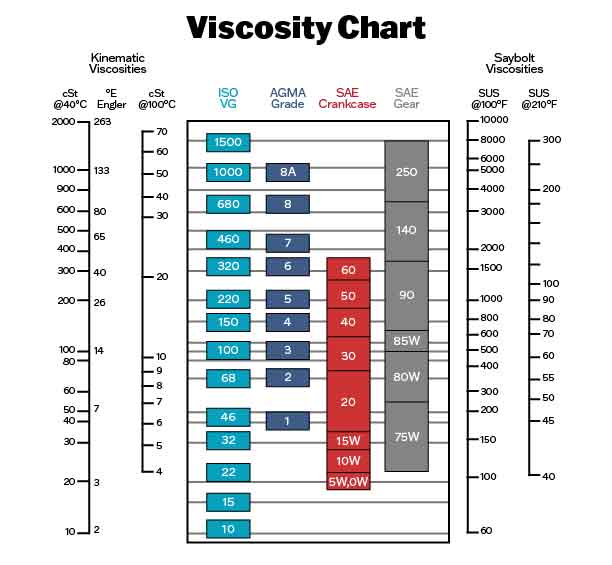
You can think of viscosity as how thick a liquid is. A liquid with high viscosity is thick, like honey, while a liquid with low viscosity is thin, like water.
Comparing water to honey is easy to understand and visualize, it leaves too wide a range when we are discussing equipment. So, we use more accurate measurements when formulating lubricants. The chart below shows the common scales that viscosity is measured on.

You can find a downloadable version of this chart here.
The lower the number on the scale, the lower the viscosity. Lower viscosity means that the oil can move around the engine quicker.
Viscosity Scales Explained
Here are the typical scales used in the industry and which common products they describe:
ISO VG - International Standards Organization Viscosity Grades
The ISO VG scale is used to classify industrial lubricants and hydraulic fluids.
AGMA Grade - American Gear Manufacturers Association Grade
AGMA Grades are a numerical rating that corresponds directly to the ISO VG scale but are for products used in industrial gear sets.
SAE Crankcase - Society of Automotive Engineers Crankcase
The SAE Crankcase scale is used to identify the viscosity of engine oils. You have the full range from 0W40’s to 15W40’s, to 10W30’s.
SAE Gear - Society of Automotive Engineers Gear Scale
The SAE gear scale identifies the viscosity for automotive gear oil. Such as those found in your differential. Today the most common product is a 75W90 GL-5 gear oil for high pressure situations.
Comparing Viscosity Using the Chart
You can see in the viscosity chart that the scales overlap. This means an ISO 220 circulating oil is the same viscosity as an AGMA 5 industrial gear lube, SAE 50 straight grade oil, as well as a 75W90 gear lube (see below).

What about oil with two numbers?
Engine oil typically comes with two numbers attached (for example, 0W40 or 10W30). The first indicates the viscosity at start-up and the second at operating temperature. Multi-grade oils flow easier at lower temperatures to help the oil reach all parts of the engine quicker. Then, when the engine is running the oil gets thicker to prevent wear. This is why the 'W' stands for Winter.
Viscosity is critical information to know when choosing lubricants.
Need to know more about viscosity? Call or text our Technical Specialist - Corey Foy at 780.238.6598.